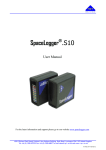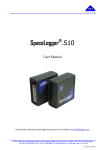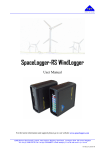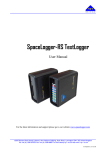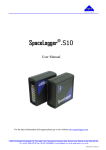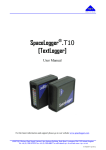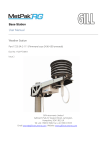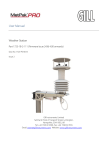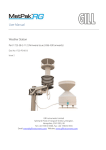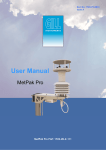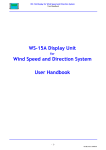Download SpaceLogger.A10 User Manual
Transcript
SpaceLogger .A10 ® Dual Channel 4-20mA Analogue Data Logger User Manual For the latest information and support please go to our website www.spacelogger.com ©2012 Richard Paul Russell Limited, New Harbour Building, Bath Road, Lymington SO41 3SE United Kingdom Tel +44 (0) 1590 679755 Fax +44 (0) 1590 688577 e-mail [email protected] web www.r-p-r.co.uk 017SL165/2 27/04/12 SpaceLogger®.A10 [Dual Channel 4-20mA Analogue Data Logger] User Manual 1 INTRODUCTION ....................................................................................................................................................2 2 QUICK START: EASY STEPS TO DATA LOGGING ............................................................................................3 3 EXAMPLE APPLICATIONS ....................................................................................................................................3 4 4.1 4.2 4.3 4.4 4.5 4.6 4.7 4.8 4.9 CONNECTING ........................................................................................................................................................4 Terminal Strip Arrangement ...............................................................................................................................4 Generic Terminal Allocations ............................................................................................................................4 Interface ..............................................................................................................................................................5 Analogue Inputs .................................................................................................................................................5 RS232 Input / Output .........................................................................................................................................5 Alarm Output ......................................................................................................................................................6 Switch Input .......................................................................................................................................................6 Cable Preparation ...............................................................................................................................................7 Power Supply .....................................................................................................................................................7 5 SETUP FEATURES .................................................................................................................................................8 5.1 Setting the time & date .......................................................................................................................................8 5.2 Format of the logged data record ........................................................................................................................9 5.3 Calculation of recorded values for each Analogue Channel .............................................................................10 5.4 Number of decimal places for each Channel ....................................................................................................10 5.5 Units text for each Channel ..............................................................................................................................11 5.6 Prefix text for each data record ........................................................................................................................11 5.7 Logging mode...................................................................................................................................................11 5.8 To define the RS232 data sample to be recorded .............................................................................................12 5.9 Trigger Conditions for enabling logging of data ..............................................................................................13 5.10 Logging rate for recording data ........................................................................................................................14 5.11 To Customise File Names ................................................................................................................................ 14 5.12 To Output RS232 Data from the SpaceLogger.A10 .........................................................................................15 5.13 Alarm Conditions .............................................................................................................................................16 5.14 To Output a File containing the current SpaceLogger.A10 Settings ................................................................ 17 5.15 Resetting the SpaceLogger.A10 to Default Settings ........................................................................................17 5.16 SETUP.TXT file ...............................................................................................................................................18 5.17 Notes on saving file SETUP.TXT ....................................................................................................................19 6 6.1 6.2 6.3 LOGGING ..............................................................................................................................................................20 SD Card ............................................................................................................................................................20 Data Transfer ....................................................................................................................................................21 Data Storage .....................................................................................................................................................21 7 SPACELOGGER.A10 SPECIFICATION ...............................................................................................................22 APPENDICES ..................................................................................................................................................................24 A1 SETUP.TXT Commands ..................................................................................................................................24 A2 ASCII – American Standard Code for Information Interchange ......................................................................26 A3 Guarantee .........................................................................................................................................................27 A4 Electromagnetic Conformity ............................................................................................................................28 A5 WEEE (Waste, Electrical and Electronic Equipment) Statement .....................................................................29 A6 RoHS Statement ...............................................................................................................................................29 ©2012 Richard Paul Russell Limited, New Harbour Building, Bath Road, Lymington SO41 3SE United Kingdom Tel +44 (0) 1590 679755 Fax +44 (0) 1590 688577 e-mail [email protected] web www.r-p-r.co.uk -1017SL165/2 27/04/12 SpaceLogger®.A10 [Dual Channel 4-20mA Analogue Data Logger] User Manual 1 INTRODUCTION SpaceLogger®.A10 is a dual channel 4-20mA analogue data logger, designed as a stand-alone solution for simple analogue data logging applications. Analogue data is sampled at 75Hz and averaged over one second with 10 bit resolution. Each data record is date & time-stamped. A new file (default format is .CSV) is generated for each day’s worth of data. The SpaceLogger.A10 will also accept a single RS232 input and a single switch input. These inputs may be logged and added to the analogue data record. Data logging may be set to be continuous or enabled only when the switch is set open or closed, defined threshold (trigger) conditions are met on either analogue channel or when a command is received on the RS232 input. The SpaceLogger.A10 will also act as an analogue to digital converter, outputting RS232 data to another device. Please refer to section 5.12 for details. This enables a series of SpaceLogger.A10 units to be daisy chained to extend the number of analogue channels logged; data is appended to the incoming serial data string. There is a single alarm output; this may be activated when the value of the analogue signal on input channel 1 and/or 2 meets set conditions or when data logging is taking place. Data is stored onto an SD card. SD or MMC cards with up to 2 GByte capacity are compatible with SpaceLogger®. Higher capacity cards are not compatible. The SD card can be removed from the logger and inserted into a card reader connected to a PC. Stored data files are accessed in the same way as files on the computer's other disk drives. The text files may be read and manipulated in any standard Office applications (e.g. Notepad or MS Excel). The logger requires a 7 - 30 volt DC supply which can be provided by an AC/DC mains adaptor or suitable battery. Document revision summary Issue 1 2 Date Feb 2012 April 2012 Description Original document Changes for software 2v0c – added Single Sample Mode and DELAY command. Additional logging and alarm conditions added. Our products are in continuous development and therefore specifications may be subject to change and design improvements may be implemented without prior notice. Please visit our web site www.r-p-r.co.uk for the most up to date information on our products. ©2012 Richard Paul Russell Limited, New Harbour Building, Bath Road, Lymington SO41 3SE United Kingdom Tel +44 (0) 1590 679755 Fax +44 (0) 1590 688577 e-mail [email protected] web www.r-p-r.co.uk -2017SL165/2 27/04/12 SpaceLogger®.A10 [Dual Channel 4-20mA Analogue Data Logger] User Manual 2 QUICK START: EASY STEPS TO DATA LOGGING ............. Connect analogue inputs ............. Connect switch if required ............. Set up logging preferences with SETUP.TXT file ............. Power on ............. Set time and date ............. Insert SD card ............. Start recording data see section 4.4 see section 4.7 see section 5 see section 4.9 see section 5.1 see section 6.1 see section 6.2 .............. ............. Stop recording data (press purge button) ............. Remove card and transfer to PC to view and analyse data see section 6.2 see section 6.2 3 EXAMPLE APPLICATIONS SD card Logging control switch (optional) Channel 1: 4-20mA Channel 2: 4-20mA Manual transfer of SD card to PC card reader SpaceLogger.A10 Figure 1 Channel 1: 4-20mA RS232 Output Channel 2: 4-20mA SD card NORMAL MODE Channel 1: 4-20mA Channel 2: 4-20mA Manual transfer of SD card to PC card reader SLAVE MODE Figure 2 – Example of 4 analogue channels logged to one SpaceLogger.A10 ©2012 Richard Paul Russell Limited, New Harbour Building, Bath Road, Lymington SO41 3SE United Kingdom Tel +44 (0) 1590 679755 Fax +44 (0) 1590 688577 e-mail [email protected] web www.r-p-r.co.uk -3017SL165/2 27/04/12 SpaceLogger®.A10 [Dual Channel 4-20mA Analogue Data Logger] User Manual 4 CONNECTING 4.1 Terminal Strip Arrangement POWER 1 2 3 4 5 6 7 8 9 10 11 12 13 14 15 16 Figure 3 4.2 Generic Terminal Allocations SpaceLogger Terminal 1 2 3 4 5 6 7 8 9 10 11 Signal description Power GND Supply +V (+7 to 30V dc) Analogue GND 1 Analogue input 1 – 0 to 20mA Analogue GND 2 Analogue input 2 – 0 to 20mA Alarm GND Alarm output Switch GND Switch input GND 12 13 14 RS232 Tx 2 RS232 Rx 2 RS232 output 1 15 16 RS232 input 1 RS232 GND 1 Use Power Input Channel 1 Input Channel 2 Alarm Output (see section 5.13) Logging control switch (see section 5.9) RS232 signal output ground (see section 5.12) Not used RS232 signal output (see section 5.12) RS232 signal input (see section 5.7) Table 1 ©2012 Richard Paul Russell Limited, New Harbour Building, Bath Road, Lymington SO41 3SE United Kingdom Tel +44 (0) 1590 679755 Fax +44 (0) 1590 688577 e-mail [email protected] web www.r-p-r.co.uk -4017SL165/2 27/04/12 SpaceLogger®.A10 [Dual Channel 4-20mA Analogue Data Logger] User Manual 4.3 Interface Connection should be made as per Table 1. This table should be read in conjunction with Figure 3. Wires should be prepared as per section 4.8. 4.4 Analogue Inputs SpaceLogger.A10 may record data from two analogue 0 to 20mA channels. The wiring connections are as described in Section 4.2: Analogue input 1 – to terminal 4 (pink) 0-20mA and terminal 3 (blue) GND Analogue input 2 – to terminal 6 (pink) 0-20mA and terminal 5 (blue) GND Please note that GND connections are common. Figure 3 shows the input circuit for the analogue inputs. 47R 4 to 20mA Sensor + - 130R 47R 4 to 20mA Sensor 1k0 100nF 10 BIT A to D 1k0 + - 130R 100nF GND SpaceLogger.A10 Figure 4 4.5 RS232 Input / Output RS232 Input: RS232 data input to RS232 Input 1 may be logged by the SpaceLogger.A10 with the analogue data when the unit is operated in slave mode. This enables loggers to be daisy chained to extend the number of channels (by recording the RS232 output from one unit to another), or for recording the serial output from an additional sensor. Refer to section 5.7 for set up details. The RS232 data input may alternatively be used as one of the trigger conditions for enabling data logging. Refer to section 5.9 for set up details. ©2012 Richard Paul Russell Limited, New Harbour Building, Bath Road, Lymington SO41 3SE United Kingdom Tel +44 (0) 1590 679755 Fax +44 (0) 1590 688577 e-mail [email protected] web www.r-p-r.co.uk -5017SL165/2 27/04/12 SpaceLogger®.A10 [Dual Channel 4-20mA Analogue Data Logger] User Manual The wiring connections for RS232 input are as described in Section 4.2 – to terminal 15 (white) RS232 Input 1 and terminal 16 (blue) GND. RS232 Output: RS232 data may be output from the SpaceLogger.A10 in various formats. Refer to section 5.12 for options and set up details. The wiring connections for RS232 output are as described in Section 4.2 – to terminal 14 (green) RS232 Output 1 and terminal 11 (blue) GND. 4.6 Alarm Output An alarm output may be activated by the value of the analogue signal on input channel 1 and/or 2. The wiring connections for the alarm output are as described in Section 4.2 – to terminal 8 (yellow) Alarm Output and terminal 7 (blue) GND. Refer to section 5.13 for options and set up details. 4.7 Switch Input The status of a switch connected between terminals 9 and 10 may be used to determine whether logging is enabled. See section 5.9 for details. The status of the switch may also be recorded as a field with each data record, if required. See section 5.2 for details. Figure 4 shows the input circuit for the switch input. 3V PROCESSOR R2 R1 R3 C1 SWITCH GND SpaceLogger.A10 Figure 5 Note: If it is required to drive a switch input directly from the user’s circuit the input signal must not exceed 3 volts. ©2012 Richard Paul Russell Limited, New Harbour Building, Bath Road, Lymington SO41 3SE United Kingdom Tel +44 (0) 1590 679755 Fax +44 (0) 1590 688577 e-mail [email protected] web www.r-p-r.co.uk -6017SL165/2 27/04/12 SpaceLogger®.A10 [Dual Channel 4-20mA Analogue Data Logger] User Manual 4.8 Cable Preparation The logger uses screwless terminals and to ease connection, wires should be prepared as per Figure 6. It is important that the stripped ends be accurately 9 to 10mm long to ensure good connections in the terminals. 9 to 10mm Tinned end Figure 6 Either solid or stranded cable is acceptable, in the range 0.32 to 0.65 mm diameter (AWG 28 to 22) with gauge 24 being ideal. Using a small flat headed screw-driver fully depress the grey plunger for the required terminal and insert the wire as far as it will go, into the hole below the plunger. Release the grey plunger and the wire is held captive by the connector. A gentle tug on the wire will confirm that it is held firmly. If the wire in question is multi-strand, ensure that all strands are inserted in the terminal hole. Please note that interconnection of all components should be completed prior to applying power. 4.9 Power Supply When the logger is powered using a 7 to 30 V DC supply the central pin on the power socket should be to GND. Alternatively, power may be supplied via terminals 1 (black) and 2 (red) on the screwless terminal connector strip, as per Table 1. Note that if power is supplied via the supply socket then terminal 2 (red) is automatically disconnected. Warning: All GNDs are common and so damage to the logger may result if they are connected to different voltages. ©2012 Richard Paul Russell Limited, New Harbour Building, Bath Road, Lymington SO41 3SE United Kingdom Tel +44 (0) 1590 679755 Fax +44 (0) 1590 688577 e-mail [email protected] web www.r-p-r.co.uk -7017SL165/2 27/04/12 SpaceLogger®.A10 [Dual Channel 4-20mA Analogue Data Logger] User Manual 5 SETUP FEATURES The SpaceLogger.A10 settings are customisable using a configuration file named SETUP.TXT written to the SD card. The following parameters may be modified using defined commands: Time & date Format of the recorded fields in each stored data record Calculation of recorded values for each analogue channel Number of decimal places for each channel Units text for each channel Prefix text for each data record Logging Mode (Slave Mode enables RS232 logging) Definition of the RS232 data sample to be recorded Trigger conditions for enabling/disabling logging Rate of logging File name of the recorded data RS232 data output Alarm Conditions Settings file output See section 5.1 See section 5.2 See section 5.3 See section 5.4 See section 5.5 See section 5.6 See section 5.7 See section 5.8 See section 5.9 See section 5.10 See section 5.11 See section 5.12 See section 5.13 See section 5.14 Refer to the sections below for command details and section 5.16 for how to create the SETUP.TXT file. Please refer to Appendix A1 for full list of commands and the valid inputs for their values and the default settings. 5.1 Setting the time & date To set the time and date for correct stamping of the data records, a file named SETUP.TXT must be created on the SD card. This file is read by the SpaceLogger when the card is inserted into the logger and the clock synchronised to the given time when the button to the left of the card slot is pressed. Steps to set the time and date: 1. Insert SD card into card reader attached to USB port of PC (or use integrated card reader if the PC has one). 2. Open notepad or similar text editor and type the following three lines: WAIT TIME=hh:mm:ss DATE=DD/MM/YYYY or DD/MM/YY ©2012 Richard Paul Russell Limited, New Harbour Building, Bath Road, Lymington SO41 3SE United Kingdom Tel +44 (0) 1590 679755 Fax +44 (0) 1590 688577 e-mail [email protected] web www.r-p-r.co.uk -8017SL165/2 27/04/12 SpaceLogger®.A10 [Dual Channel 4-20mA Analogue Data Logger] User Manual Where hh:mm:ss is the time in, say, a couple of minutes and DD/MM/YYYY or DD/MM/YY is today’s date. 3. Save this text file as SETUP.TXT on the SD card in the root folder. (Note: if folder DATA already exists on the card, ensure the file SETUP.TXT is not in this folder but at the top level in the root directory). If using Vista or higher version of Windows, please refer to section 5.17. 4. Remove card from card reader and, with the power on, insert the card into the SpaceLogger. Both the red and green LEDs will come on. 5. At the time saved in the SETUP.TXT file, press the button to the left of the card slot. The SpaceLogger will ‘Beep’ once and both LED’s switch off. Release the button. The red LED may flicker on and off after this and once the card has completed its initialisation the green LED will come back on and remain on. [Note that when waiting for the button to be pressed output from the logger will be interrupted.] 6. After updating the time and date, the SpaceLogger renames the file SETUP.TXT to SETUPOLD.TXT to avoid unintentionally repeating the commands next time the unit is switched on or the card re-inserted. The SpaceLogger has an internal battery to maintain the time and date when the power to the unit is switched off. When it is necessary to reset the time and date, please repeat the steps outlined above. If no time and date is set up on the SpaceLogger, the unit will emit a warning ‘Beep’ four times a minute as a reminder. 5.2 Format of the logged data record The recorded log string for a data record consists of comma separated fields. The fields required in each data record may be defined using command FORMAT. The fields that may be specified for command FORMAT are: P Prefix T Time and date C1 Channel 1 (see section 5.3 for calculation of C1) U1 Units text for Channel 1 C2 Channel 2 (see section 5.3 for calculation of C2) U2 Units text for Channel 2 SW Switch state (0 if open, 1 if closed) Example: FORMAT=P T C1 U1 SW Where the recorded log string would consist of the following fields: Prefix, Date, Time, Channel 1, Units for Channel 1, Switch state The record will end with <CR> <LF> (carriage return and line feed). ©2012 Richard Paul Russell Limited, New Harbour Building, Bath Road, Lymington SO41 3SE United Kingdom Tel +44 (0) 1590 679755 Fax +44 (0) 1590 688577 e-mail [email protected] web www.r-p-r.co.uk -9017SL165/2 27/04/12 SpaceLogger®.A10 [Dual Channel 4-20mA Analogue Data Logger] User Manual 5.3 Calculation of recorded values for each Analogue Channel For each analogue Channel, the measured value (in mA) may be converted to a calculated value (in the correct units) for logging purposes. The calculated values for channel 1 and 2 are used to populate fields C1 and C2 in each data record. The required calculated values may be achieved by using commands OFFSET1, OFFSET2, SCALE1, SCALE2, POWER1 and POWER2. For each channel: C1 = [(A1 + OFFSET1) x SCALE1] x 10^POWER1 C2 = [(A2 + OFFSET2) x SCALE2] x 10^POWER2 Where for Channel 1: A1 OFFSET1 SCALE1 POWER1 Measured value in mA x 100 Offset in mA x 100 Scaling factor Exponent for power of 10 multiplier And for Channel 2: A2 OFFSET2 SCALE2 POWER2 Measured value in mA x 100 Offset in mA x 100 Scaling factor Exponent for power of 10 multiplier Example: Measured value of Channel 1 = 15.01mA Commands: OFFSET1=-1 SCALE1=2 POWER=-2 Therefore, C1 = [(1501 + (-1)) x 2] x 10^(-2) = 30.00 5.4 Number of decimal places for each Channel For each channel it is possible to define the number of places required after the decimal point by using commands DP1 and DP2. For each channel: DP1=x DP2=x Where x is the maximum number of places required after the decimal point. This command will only remove, not add, decimal places to the calculated values of C1 and C2. Please note that the result is not rounded up or down; only that the least significant digits are truncated. ©2012 Richard Paul Russell Limited, New Harbour Building, Bath Road, Lymington SO41 3SE United Kingdom Tel +44 (0) 1590 679755 Fax +44 (0) 1590 688577 e-mail [email protected] web www.r-p-r.co.uk - 10 017SL165/2 27/04/12 SpaceLogger®.A10 [Dual Channel 4-20mA Analogue Data Logger] User Manual 5.5 Units text for each Channel For each Channel, the units text for populating fields U1 and U2 in each data record may be defined by commands UNITS1 and UNITS2. The Units text may consist of up to 10 characters and must be enclosed in “ ” marks. Examples: UNITS1=”mA” UNITS2=”DegreesC” 5.6 Prefix text for each data record The Prefix text for populating field P in each data record may be defined using command PREFIX. This may be useful in labelling results from different test sets. The Prefix text may consist of up to 10 characters and must be enclosed in “ ” marks. Example: PREFIX=”Test#1” 5.7 Logging mode The SpaceLogger.A10 may be run in one of three modes, controlled by command MODE. MODE = NORMAL Normal Mode where logging conditions are defined by commands TRIGGER and RATE. MODE = SINGLE Single Sample Mode where a single reading is logged in response to an event defined by command TRIGGER. A delay from the time that the trigger conditions become true to the reading that will be logged can be specified by command DELAY. MODE = SLAVE Slave Mode where each time a serial data sample is received (as defined by STX and ETX commands) on RS232 Input 1, this string is logged and the data fields defined by command FORMAT appended to the data record. Section 4.5 describes the connection of the RS232 Input 1 used in Slave Mode. The serial data may be either the RS232 output from another SpaceLogger.A10 or the serial output from another sensor or device. The serial data sample recorded is defined by commands STX and ETX. Refer to section 5.8 for set up details. Switching to Slave Mode disables both the command TRIGGER and command RATE. ©2012 Richard Paul Russell Limited, New Harbour Building, Bath Road, Lymington SO41 3SE United Kingdom Tel +44 (0) 1590 679755 Fax +44 (0) 1590 688577 e-mail [email protected] web www.r-p-r.co.uk - 11 017SL165/2 27/04/12 SpaceLogger®.A10 [Dual Channel 4-20mA Analogue Data Logger] User Manual 5.8 To define the RS232 data sample to be recorded When operated in Slave Mode, the SpaceLogger.A10 is capable of recording ASCII sentences from a single RS232 input. The format of the data must be 8 bits and no parity. It is also a requirement that each data record has identifying start (STX) and end (ETX) characters to define the data sequence to be sampled. When operated in Normal or Single Sample Modes, the STX and ETX identifiers may be used to control logging via the TRIGGER command – see section 5.9. The start and end characters may be defined in one of two ways: a) Single Unique Start and End Characters: This method requires a single unique identifying start character and a different identifying end character. The SpaceLogger.A10 only records the ASCII characters between these start and end characters. The SpaceLogger.A10 may be set to recognise any start and end characters using the following SETUP.TXT command lines: STX=s ETX=e Where: s is the decimal value (0-255) of the ASCII character that indicates the start of the data string that is to be stored. Default value is 2 <STX>. * And, e is decimal value (0-255) of the ASCII character that indicates the end of the data string that is to be stored. Default value 3 <ETX>. * * For table of ASCII characters and their decimal values, refer to the Appendix A2. b) Start String and Single End Character: Alternatively, a string of up to 15 characters may be specified for identifying the start of the data to be recorded. The procedure to set up the SpaceLogger.S10 to recognise the start and end identifiers is as described above, but in this case: STX=“aaaaaaaaaaaaaaa” Where: aaaaaaaaaaaaaaa is a string of up to 15 ASCII characters. Note: The string must be enclosed in “ “ marks. The string is case sensitive. Question marks (?) may be used to denote any character i.e. as wildcards. ©2012 Richard Paul Russell Limited, New Harbour Building, Bath Road, Lymington SO41 3SE United Kingdom Tel +44 (0) 1590 679755 Fax +44 (0) 1590 688577 e-mail [email protected] web www.r-p-r.co.uk - 12 017SL165/2 27/04/12 SpaceLogger®.A10 [Dual Channel 4-20mA Analogue Data Logger] User Manual Example: If the logger was required to record the position from a GPS every 10 seconds, the following could be specified to record every 10th RMC sentence of an NMEA data stream: STX=“$??RMC,?????0” A table of ASCII characters and their decimal values is included in the Appendix A2. The baud rate of the RS232 input may be selected using command BAUD. The default baud rate is 9600 baud. BAUD=b Where b is the baud rate. Valid baud rates are 115200, 57600, 38400, 19200, 9600, 4800, 2400, 1200, 300 and 110 bits per second. Data will always be output at 8 bits and no parity. Note that command BAUD controls both RS232 input and output baud rates 5.9 Trigger Conditions for enabling logging of data When operated in Normal Mode or Single Sample Mode, logging of data by the SpaceLogger.A10 may be restricted to the time when certain conditions are true. The conditions may be selected from the level of inputs on either Channel 1 or Channel 2 and/or the position of a switch across the Digital I/O terminals and/or commands received on the RS232 input. The conditions to enable data logging are controlled by command TRIGGER. The conditions that may be specified for command TRIGGER are: +C1 -C1 +C2 -C2 +C1-C1 +C2-C2 SC SO RS232 & start when Channel 1>= STARTLEVEL1, stop when Channel 1<STOPLEVEL1 start when Channel 1<= STARTLEVEL1, stop when Channel 1>STOPLEVEL1 start when Channel 2>= STARTLEVEL2, stop when Channel 2<STOPLEVEL2 start when Channel 2<= STARTLEVEL2, stop when Channel 2>STOPLEVEL2 if STARTLEVEL1 < STOPLEVEL1 log if Channel 1 >= STARTLEVEL1 and Channel 1 < STOPLEVEL1 if STARTLEVEL1>= STOPLEVEL1 log if Channel 1 >= STARTLEVEL1 or Channel 1 < STOPLEVEL1 if STARTLEVEL2 < STOPLEVEL2 log if Channel 2 >= STARTLEVEL2 and Channel 2 < STOPLEVEL2 if STARTLEVEL2>= STOPLEVEL2 log if Channel 2 >= STARTLEVEL2 or Channel 2 < STOPLEVEL2 log when switch closed log when switch open start when STX is received, stop when ETX is received log only when all selected conditions are true Examples: ©2012 Richard Paul Russell Limited, New Harbour Building, Bath Road, Lymington SO41 3SE United Kingdom Tel +44 (0) 1590 679755 Fax +44 (0) 1590 688577 e-mail [email protected] web www.r-p-r.co.uk - 13 017SL165/2 27/04/12 SpaceLogger®.A10 [Dual Channel 4-20mA Analogue Data Logger] User Manual TRIGGER=+C1SC Enables the SpaceLogger.A10 to only log when either condition +C1 is true or the switch is closed. TRIGGER=&+C1-C2 Enables the SpaceLogger.A10 to only log when conditions +C1 and –C2 are both true. The threshold levels for conditions +C1, -C1, +C2 and –C2 may be set with the following commands: STARTLEVEL1 STOPLEVEL1 STARTLEVEL2 STOPLEVEL2 Channel 1 logging start value in mA x 100 (as per measured value) Channel 1 logging stop value in mA x 100 (as per measured value) Channel 2 logging start value in mA x 100 (as per measured value) Channel 2 logging stop value in mA x 100 (as per measured value) The default setting for TRIGGER is TRIGGER=SO. By default the SpaceLogger.A10 will log for all values of Channel 1 and Channel 2 inputs whenever the switch on the digital I/O terminals is open (as supplied). For details on how to set up commands STX and ETX, see section 5.8 Note that command TRIGGER is disabled when operating in slave mode (MODE=SLAVE) 5.10 Logging rate for recording data The frequency of the logging of data may be set with command RATE. RATE=r Where r is integer value for logging rate in seconds from 1 to 60 Example: RATE=5 Data will log every 5 seconds The analogue values are measured 75 times a second and averaged over each second. Setting RATE to longer than one second does not increase the averaging time period. 5.11 To Customise File Names The default file name for each day’s data is 20YYMMDD.CSV where YYMMDD is that day’s date. This may be customised to the format ffYYMMDD.nnn by using the following SETUP.TXT command line: FILE=ff.nnn ©2012 Richard Paul Russell Limited, New Harbour Building, Bath Road, Lymington SO41 3SE United Kingdom Tel +44 (0) 1590 679755 Fax +44 (0) 1590 688577 e-mail [email protected] web www.r-p-r.co.uk - 14 017SL165/2 27/04/12 SpaceLogger®.A10 [Dual Channel 4-20mA Analogue Data Logger] User Manual Where: ff is a pair of ASCII characters that set the start of the file name. Default characters are 20. And, nnn are the ASCII character that set the file extension. Default characters are CSV. Note: Lower case characters are converted to upper case characters so will not be differentiated. The stored file name will now take the format: ffYYMMDD.nnn 5.12 To Output RS232 Data from the SpaceLogger.A10 It is possible to output serial RS232 data from the SpaceLogger.A10. This output is controlled by command OUTPUT. The conditions for output from the RS232 Output 1 are defined as follows: OUTPUT=A OUTPUT=C OUTPUT=T OUTPUT=L OUTPUT= output on ALARM condition being true output continuously output when the TRIGGER condition is true output all values as logged to the memory card no output The SpaceLogger.A10 will output data (in the selected format) to the RS232 Output 1 terminal. The wiring connections for RS232 output are as described in Section 4.2 – to terminal 11 (blue) GND and terminal 14 (green) RS232 Output 1. The baud rate of the output serial data may be selected using command BAUD. The default baud rate is 9600 baud. BAUD=b Where b is the baud rate. Valid baud rates are 115200, 57600, 38400, 19200, 9600, 4800, 2400, 1200, 300 and 110 bits per second. Data will always be output at 8 bits and no parity. Note that command BAUD controls both RS232 input and output baud rates ©2012 Richard Paul Russell Limited, New Harbour Building, Bath Road, Lymington SO41 3SE United Kingdom Tel +44 (0) 1590 679755 Fax +44 (0) 1590 688577 e-mail [email protected] web www.r-p-r.co.uk - 15 017SL165/2 27/04/12 SpaceLogger®.A10 [Dual Channel 4-20mA Analogue Data Logger] User Manual 5.13 Alarm Conditions The SpaceLogger.A10 alarm signal is output on terminal 8 (yellow). Wiring instructions are as per section 4.6. The alarm can be activated by the level on one or both analogue channels and/or if logging. High/low with hysteresis or in/out of band conditions can be specified using the ALARM command and an ALARM_ON and ALARM_OFF value for each channel. The conditions that may be specified for command ALARM are: +A1 -A1 +A2 -A2 +A1-A1 +A2-A2 L & start when Channel 1>= ALARM_ON1, stop when Channel 1<ALARM_OFF1 start when Channel 1<= ALARM_ON1, stop when Channel 1> ALARM_OFF1 start when Channel 2>= ALARM_ON2, stop when Channel 2< ALARM_OFF2 start when Channel 2<= ALARM_ON2, stop when Channel 2> ALARM_OFF2 if ALARM_ON1 < ALARM_OFF1 Alarm if Channel 1 >= ALARM_ON1 and Channel 1 < ALARM_OFF1 if ALARM_ON1>=ALARM_OFF1 Alarm if Channel 1 >= ALARM_ON1 or Channel 1 < ALARM_OFF1 if ALARM_ON2 < ALARM_OFF2 Alarm if Channel 2 >= ALARM_ON2 and Channel 2 < ALARM_OFF2 if ALARM_ON2>=ALARM_OFF2 Alarm if Channel 2 >= ALARM_ON2 or Channel 2 < ALARM_OFF2 alarm when logging and, when in Normal or Single Sample Mode, that the TRIGGER condition is true alarm only when all selected conditions are true Examples: ALARM=+A1-A2 The SpaceLogger.A10 will enable the alarm output when either condition +A1 or –A2 is true. ALARM=&+A1L The SpaceLogger.A10 will only enable the alarm output when both condition +A1 is true and data is being recorded. ALARM_ON and ALARM_OFF values may be set with the following commands: ALARM_ON1 ALARM_OFF1 ALARM_ON2 ALARM_OFF2 Channel 1 alarm on value in mA x 100 (as per measured value) Channel 1 alarm off value in mA x 100 (as per measured value) Channel 2 alarm on value in mA x 100 (as per measured value) Channel 2 alarm off value in mA x 100 (as per measured value) Example: ALARM_ON1=450 Will set the ALARM_ON value for channel 1 at 4.50mA ©2012 Richard Paul Russell Limited, New Harbour Building, Bath Road, Lymington SO41 3SE United Kingdom Tel +44 (0) 1590 679755 Fax +44 (0) 1590 688577 e-mail [email protected] web www.r-p-r.co.uk - 16 017SL165/2 27/04/12 SpaceLogger®.A10 [Dual Channel 4-20mA Analogue Data Logger] User Manual 5.14 To Output a File containing the current SpaceLogger.A10 Settings To obtain information about how the SpaceLogger.A10 is currently configured, each time the memory card is initialised (either on power on or when the card is inserted), a file named SETTINGS.TXT may be output to the memory card. This SETTINGS.TXT file contains a list of all the logger settings. To control the output of this file, the command SETTINGS is used. SETTINGS=F SETTINGS=L SETTINGS= The settings are written to file SETTINGS.TXT, overwriting the contents of the file if it already exists. A log of the settings is maintained in file SETTINGS.TXT; current settings are appended to the file each time the memory card is initialised. File SETTINGS.TXT is not generated. File SETTINGS.TXT is saved to the memory card in the root directory. 5.15 Resetting the SpaceLogger.A10 to Default Settings To intentionally return to the default settings, create a new SETUP.TXT file containing the command line: RESET For the default values for all commands, please refer to Appendix A1 ©2012 Richard Paul Russell Limited, New Harbour Building, Bath Road, Lymington SO41 3SE United Kingdom Tel +44 (0) 1590 679755 Fax +44 (0) 1590 688577 e-mail [email protected] web www.r-p-r.co.uk - 17 017SL165/2 27/04/12 SpaceLogger®.A10 [Dual Channel 4-20mA Analogue Data Logger] User Manual 5.16 SETUP.TXT file The SETUP.TXT file is created as follows: 1. Insert SD card into card reader attached to USB port of PC (or use integrated card reader if the PC has one). 2. Open notepad or similar text editor and type the required command line or lines. Refer to sections above for explanation of commands. 3. Commands may be typed in upper or lower case but they will be converted to upper case before execution. 4. The SETUP.TXT file may contain a list of commands. For example, to set up all available parameters, the file SETUP.TXT should contain the following lines: WAIT TIME= DATE= FORMAT= OFFSET1= SCALE1= POWER1= OFFSET2= SCALE2= POWER2= DP1= DP2= PREFIX=”” UNITS1=”” UNITS2=”” TRIGGER= STARTLEVEL1= STOPLEVEL1= STARTLEVEL2= STOPLEVEL2= ALARM= ALARM_ON1= ALARM_ON2= ALARM_OFF1= ALARM_OFF2= RATE= FILE= OUTPUT= BAUD= MODE= DELAY= STX= ETX= SETTINGS= ©2012 Richard Paul Russell Limited, New Harbour Building, Bath Road, Lymington SO41 3SE United Kingdom Tel +44 (0) 1590 679755 Fax +44 (0) 1590 688577 e-mail [email protected] web www.r-p-r.co.uk - 18 017SL165/2 27/04/12 SpaceLogger®.A10 [Dual Channel 4-20mA Analogue Data Logger] User Manual 5. Comments may be added to the SETUP.TXT file using //. The SpaceLogger will not read any text following // until the end of the line. 6. Save this text file as SETUP.TXT on the SD card in the root folder. (Note: if folder DATA already exists on the card, ensure the file SETUP.TXT is not in this folder but at the top level in the root directory.) If using Vista or higher versions of Windows, please also refer to section 5.17. 7. Remove card from card reader and insert the card into the SpaceLogger.A10. 8. The command lines will now be effective. The configuration is saved to the SpaceLogger.A10 and the file SETUP.TXT automatically renamed to SETUP_OLD.TXT. 9. To intentionally return to the default settings, a new SETUP.TXT file must be created containing the command RESET 5.17 Notes on saving file SETUP.TXT File SETUP.TXT must have its name and file extension in capitals, e.g. not SETUP.txt. To ensure saving correctly from Notepad or similar text editor, select ‘Save As...’. When the Save As box appears, select ‘All Files’ from the pull down list next to ‘Save as type:’ and type SETUP.TXT in the File name box. With Vista and higher version of Windows it is beneficial to have File Extensions visible when viewing documents in Explorer. ©2012 Richard Paul Russell Limited, New Harbour Building, Bath Road, Lymington SO41 3SE United Kingdom Tel +44 (0) 1590 679755 Fax +44 (0) 1590 688577 e-mail [email protected] web www.r-p-r.co.uk - 19 017SL165/2 27/04/12 SpaceLogger®.A10 [Dual Channel 4-20mA Analogue Data Logger] User Manual 6 LOGGING Red LED: Power on and Writing data to card Green LED: ON: Ready to Record Data Clock synchronisation, Stop Recording & Buffer Purge Button Card Slot for SD card insertion Figure 7 6.1 SD Card Once the time and date have been set on the SpaceLogger; when the SD card is inserted correctly into the SpaceLogger (with power supplied), the unit should ‘Beep’ once and the red LED blink as the card initialises. At this stage, the SpaceLogger’s internal buffer is cleared and is ready to start receiving new data from the connected equipment. The green LED will then switch on indicating that the unit is ‘Ready to Record Data’. The green LED will remain on while the unit is in this state. The SD card is designed to fit easily into the card slot one way only. Do not bend the card or force it into the slot. ©2012 Richard Paul Russell Limited, New Harbour Building, Bath Road, Lymington SO41 3SE United Kingdom Tel +44 (0) 1590 679755 Fax +44 (0) 1590 688577 e-mail [email protected] web www.r-p-r.co.uk - 20 017SL165/2 27/04/12 SpaceLogger®.A10 [Dual Channel 4-20mA Analogue Data Logger] User Manual 6.2 Data Transfer When the logging conditions are met, logging is enabled and the SpaceLogger.A10 will start recording data. The red LED blinks each time data is written to the card. The SD card should not be removed while data is being written to it. To stop recording data, the small button to the left of the card slot on the front of the SpaceLogger should be depressed. There will be an audio signal to indicate that the button has been pressed. This action will also purge any data in the buffer to the SD card so the card is ready to be removed from the SpaceLogger. The green LED will automatically switch off to indicate that the unit is no longer enabled to record further data and it is safe to remove the card. To recommence data logging the power must be cycled or a card re-inserted in order to reinitialise the card. The green LED will again indicate the unit as ‘Ready to Record Data’. To avoid losing data or corrupting the card, never remove the card or disconnect the power supply when the red LED is flashing or blinking. 6.3 Data Storage SpaceLogger.A10 creates a folder DATA on the SD card root folder. Data files are written to this folder. A new file is generated each day. The file name takes the default format 20YYMMDD.CSV where YYMMDD is that day’s date. As default, data is stored in comma separated variable format files (.CSV) which may be opened in MS Excel and other spreadsheet programs. These files are also readable in notepad or a similar text editor. To change the file name, including the file extension, refer to section 5.11. ©2012 Richard Paul Russell Limited, New Harbour Building, Bath Road, Lymington SO41 3SE United Kingdom Tel +44 (0) 1590 679755 Fax +44 (0) 1590 688577 e-mail [email protected] web www.r-p-r.co.uk - 21 017SL165/2 27/04/12 SpaceLogger®.A10 [Dual Channel 4-20mA Analogue Data Logger] User Manual 7 SPACELOGGER.A10 SPECIFICATION Physical Width: 67 mm Dimensions Depth: 67 mm Height: 28 mm (excluding optional rubber feet) Weight 75g Enclosure material GP ABS (UL94-HB) plastic and acrylic Connections Analogue Input Switch Input Type Number of channels Range Sampling Maximum logging rate Input impedance Accuracy Drift with temperature Analogue to digital converter Digital channel Max input voltage Current out Number of channels Transmission standard RS232 Input Transmission speed Data Sample Transmission standard Transmission speed RS232 Output Output rate Alarm Output Min output voltage Screwless terminals capable of accepting wire 0.32 to 0.65mm diameter (AWG 28 to 22) 2 4 to 20 mA (0 to 23 mA maximum) Readings are sampled at 75 Hz and averaged over 1 sec 1 Hz 177 ohms ±1% or 0.1 mA at 20 ºC over range 4 to 20 mA 100 ppm / ºC over range -40 ºC to +40 ºC 10-bit resolution Input for logging control switch Must not exceed 3V 7µA max 1 RS232 compatible, 8 bits and no parity 9600 Baud (default) or selectable from 115200, 57600, 38400, 19200, 4800, 2400, 1200, 300 or 110 Baud Records only the data between specified start (STX) and end (ETX) characters RS232 compatible, 8 bits and no parity 9600 Baud (default) or selectable from 115200, 57600, 38400, 19200, 4800, 2400, 1200, 300 or 110 Baud Normal Mode: 1 data record per 1 to 60 seconds – selectable Slave Mode: rate determined by input of RS232 data sample defined by STX and ETX VOH=1.7V Typ @ 1mA output current Data Storage Card Removable SD, MMC or MMC mobile card Data Capacity 2 GByte (max) Data Storage File System FAT16 or FAT32 with 8.3 file names Sector size 512 Bytes Normal Mode: 1 data record per 1 to 60 seconds – selectable Data logging interval Slave Mode: rate determined by input of RS232 data sample defined by STX and ETX LED Indicators Audible / Visual Indicators Real Time Clock Green: Ready to record data Red: Power on | Writing data to SD card Two tone signal on correct card insertion. Audio Bleeper Single tone when data purge button depressed. Four bleeps per minute when time & date not set. Accuracy ±40 ppm at 25 ºC Backup battery CR2032 Power requirement 7 to 30 Vdc Power Current at 12Vdc 10 mA typical Supply input protection Polarity reversal protected and internal re-settable fuse – 140 mA Connection 1.3 mm centre pin DC connector, or ©2012 Richard Paul Russell Limited, New Harbour Building, Bath Road, Lymington SO41 3SE United Kingdom Tel +44 (0) 1590 679755 Fax +44 (0) 1590 688577 e-mail [email protected] web www.r-p-r.co.uk - 22 017SL165/2 27/04/12 SpaceLogger®.A10 [Dual Channel 4-20mA Analogue Data Logger] User Manual Screwless terminals (0.32 to 0.64 mm, AWG 28 to 22 diameter conductors) Environmental Operating Temperature -25 ºC to +70 ºC Range Storage Temperature Range -40 ºC to +70 ºC Enclosure protection IP203 Guarantee Period 1 year (refer to Appendix) ©2012 Richard Paul Russell Limited, New Harbour Building, Bath Road, Lymington SO41 3SE United Kingdom Tel +44 (0) 1590 679755 Fax +44 (0) 1590 688577 e-mail [email protected] web www.r-p-r.co.uk - 23 017SL165/2 27/04/12 SpaceLogger®.A10 [Dual Channel 4-20mA Analogue Data Logger] User Manual APPENDICES A1 SETUP.TXT Commands Command Description Valid command inputs Default value Puts SpaceLogger in ‘wait’ mode for clock synchronisation N/A N/A TIME= DATE= Time at which clock will be synchronised hh:mm:ss none Date at which clock will be synchronised DD/MM/YYYY DD/MM/YY none FORMAT= Defines which fields are included in each data record [There will be no logged data if no field is specified] P T C1 U1 C2 U2 SW [any combination of above] P T C1 U1 C2 U2 SW OFFSET1= Channel 1 correction offset in mA x100 -32767 to 32767 [integer value] 0 OFFSET2= Channel 2 correction offset in mA x100 -32767 to 32767 [integer value] 0 SCALE1= Channel 1 scaling factor -32767 to 32767 [integer value] 1 SCALE2= Channel 2 scaling factor -32767 to 32767 [integer value] 1 POWER1= Channel 1 exponent for power of 10 multiplier -10 to 10 [integer value] -2 POWER2= Channel 2 exponent for power of 10 multiplier -10 to 10 [integer value] -2 DP1= Channel 1 maximum number of places required after the decimal point 0 to 10 2 DP2= Channel 2 maximum number of places required after the decimal point 0 to 10 2 PREFIX= Prefix text that may be used to populate field P in a data record (to provide a test label) Up to 10 characters enclosed in “” “A10” UNITS1= Channel 1 units text that may be used to populate field U1 in a data record Up to 10 characters enclosed in “” “mA” UNITS2= Channel 2 units text that may be used to populate field U2 in a data record Up to 10 characters enclosed in “” “mA” TRIGGER= Defines the conditions when data logging is enabled +C1 -C1 +C2 -C2 +C1-C1 +C2-C2 SC SO RS232 & SO STARTLEVEL1= Channel 1 logging start value in mA x100 0 to 2300 [integer value] 0 STOPLEVEL1= Channel 1 logging stop value in mA x100 0 to 2300 [integer value] 0 STARTLEVEL2= Channel 2 logging start value in mA x100 0 to 2300 [integer value] 0 WAIT ©2012 Richard Paul Russell Limited, New Harbour Building, Bath Road, Lymington SO41 3SE United Kingdom Tel +44 (0) 1590 679755 Fax +44 (0) 1590 688577 e-mail [email protected] web www.r-p-r.co.uk - 24 017SL165/2 27/04/12 SpaceLogger®.A10 [Dual Channel 4-20mA Analogue Data Logger] User Manual Channel 2 logging stop value in mA x100 0 to 2300 [integer value] Defines the conditions when alarm is activated +A1 -A1 +A2 -A2 +A1-A1 +A2-A2 L & ALARM_ON1= Channel 1 alarm on value in mA x100 0 to 2300 [integer value] 0 ALARM_ON2= Channel 2 alarm on value in mA x100 0 to 2300 [integer value] 0 ALARM_OFF1= Channel 1 alarm off value in mA x100 0 to 2300 [integer value] 0 ALARM_OFF2= Channel 2 alarm off value in mA x100 0 to 2300 [integer value] 0 RATE= Frequency of data logging in seconds 1 to 60 [integer value] 1 File name and extension format ff.nnn 20.CSV Controls RS232 output of data [There will be no output if no value is specified] A C L T C BAUD= Sets baud rate for RS232 data input and output 115200 57600 38400 19200 9600 4800 2400 1200 300 110 9600 MODE= Logging mode – normal mode, single sample mode or slave mode NORMAL SINGLE SLAVE NORMAL DELAY= In single sample mode defines the delay from the trigger event to the reading that will be logged. 0 to 255 [integer value] 0 STX= In normal mode defines the character(s) used to start logging (via TRIGGER command) In slave mode defines the start character(s) of the data sample to be logged “cc…cc” Up to 15 characters enclosed in “” Or The decimal value of a single ASCII character 2 ETX= In normal mode defines the character(s) used to stop logging (via TRIGGER command) In slave mode defines the end character(s) of the data sample to be logged “cc…cc” Up to 15 characters enclosed in “” Or The decimal value of a single ASCII character 3 SETTINGS= Defines if the logger’s settings / configuration is output to a SETTINGS.TXT file. [Settings will not be output if no value is specified] F L F Returns logger to default settings N/A N/A STOPLEVEL2= ALARM= FILE= OUTPUT= RESET 0 ©2012 Richard Paul Russell Limited, New Harbour Building, Bath Road, Lymington SO41 3SE United Kingdom Tel +44 (0) 1590 679755 Fax +44 (0) 1590 688577 e-mail [email protected] web www.r-p-r.co.uk - 25 017SL165/2 27/04/12 SpaceLogger®.A10 [Dual Channel 4-20mA Analogue Data Logger] User Manual ASCII – American Standard Code for Information Interchange A2 Value Hex Character Value Hex Character Value Hex Character Value Hex Character 0 00H NUL 16 10H DLE 32 20H SP 48 30H 0 1 01H SOH 17 11H DC1 33 21H ! 49 31H 1 2 02H STX 18 12H DC2 34 22H " 50 32H 2 3 03H ETX 19 13H DC3 35 23H # 51 33H 3 4 04H EOT 20 14H DC4 36 24H $ 52 34H 4 5 05H ENQ 21 15H NAK 37 25H % 53 35H 5 6 06H ACK 22 16H SYN 38 26H & 54 36H 6 7 07H BEL 23 17H ETB 39 27H ' 55 37H 7 8 08H BS 24 18H CAN 40 28H ( 56 38H 8 9 09H HT 25 19H EM 41 29H ) 57 39H 9 10 0AH LF 26 1AH SUB 42 2AH * 58 3AH : 11 0BH VT 27 1BH ESC 43 2BH + 59 3BH ; 12 0CH FF 28 1CH FS 44 2CH , 60 3CH < 13 0DH CR 29 1DH GS 45 2DH - 61 3DH = 14 0EH SO 30 1EH RS 46 2EH . 62 3EH > 15 0FH SI 31 1FH US 47 2FH / 63 3FH ? Value Hex Character Value Hex Character Value Hex Character Value Hex Character 64 40H @ 80 50H P 96 60H ` 112 70H p 65 41H A 81 51H Q 97 61H a 113 71H q 66 42H B 82 52H R 98 62H b 114 72H r 67 43H C 83 53H S 99 63H c 115 73H s 68 44H D 84 54H T 100 64H d 116 74H t 69 45H E 85 55H U 101 65H e 117 75H u 70 46H F 86 56H V 102 66H f 118 76H v 71 47H G 87 57H W 103 67H g 119 77H w 72 48H H 88 58H X 104 68H h 120 78H x 73 49H I 89 59H Y 105 69H i 121 79H y 74 4AH J 90 5AH Z 106 6AH j 122 7AH z 75 4BH K 91 5BH [ 107 6BH k 123 7BH { 76 4CH L 92 5CH \ 108 6CH l 124 7CH | 77 4DH M 93 5DH ] 109 6DH m 125 7DH } 78 4EH N 94 5EH ^ 110 6EH n 126 7EH ~ 79 4FH O 95 5FH _ 111 6FH o 127 7FH DEL ©2012 Richard Paul Russell Limited, New Harbour Building, Bath Road, Lymington SO41 3SE United Kingdom Tel +44 (0) 1590 679755 Fax +44 (0) 1590 688577 e-mail [email protected] web www.r-p-r.co.uk - 26 017SL165/2 27/04/12 SpaceLogger®.A10 [Dual Channel 4-20mA Analogue Data Logger] User Manual A3 Guarantee System components are warranted for a period of twelve (12) months from the original date of purchase, against defective materials and workmanship. In the event that warranty service is required, please contact Richard Paul Russell Ltd. This warranty is only valid if, when warranty service is required, a full description of the fault is provided and presented with the original invoice, and the serial number(s) on the component has not been defaced. Richard Paul Russell Ltd’s liability is limited to items of its own manufacture, and it does not accept liability for any loss resulting from the operation or interpretation of the results from this equipment. This warranty covers none of the following: Periodic check ups, maintenance and repair or replacement of parts due to normal wear and tear. Cost relating to transport, removal, or installation of the component. Misuse, including failure to use the component for its normal purpose or incorrect installation. Damage caused by Lightning, Water, Fire, Acts of God, War, Public Disturbances, incorrect supply voltage or any other cause beyond the control of Richard Paul Russell Ltd. Units which have been repaired or units altered by a party other than Richard Paul Russell Ltd’s employees or agents without prior written consent from Richard Paul Russell Ltd. In no event shall Richard Paul Russell Ltd be liable under any circumstances for any direct, indirect or consequential damages, any financial loss or any lost data contained in any product (including any returned product), regardless of the cause of loss. Richard Paul Russell Ltd products are not warranted to operate without failure. Richard Paul Russell Ltd’s products must not be used in life support systems or other application where failure could threaten injury or life. The Customers statutory rights are not affected by this warranty. Unless there is national legislation to the contrary, the rights under this warranty are the customer’s sole rights and Richard Paul Russell Ltd shall not be liable for indirect or consequential loss or damage to any other related equipment or material. ©2012 Richard Paul Russell Limited, New Harbour Building, Bath Road, Lymington SO41 3SE United Kingdom Tel +44 (0) 1590 679755 Fax +44 (0) 1590 688577 e-mail [email protected] web www.r-p-r.co.uk - 27 017SL165/2 27/04/12 SpaceLogger®.A10 [Dual Channel 4-20mA Analogue Data Logger] User Manual A4 Electromagnetic Conformity EC DECLARATION OF CONFORMITY ACCORDING TO COUNCIL DIRECTIVE 2004/108/EC We, Richard Paul Russell Limited of New Harbour Building Bath Road Lymington Hampshire SO41 3SE United Kingdom Declare under our sole responsibility that the product: SpaceLogger-RS Manufactured by: Richard Paul Russell Limited to which this declaration relates, is in conformity with the protection requirements of Council Directive 2004/108/EC on the approximation of the laws relating to electromagnetic compatibility. This Declaration of Conformity is based upon compliance of the product with the following harmonised standards: Emissions EN 61326:2006 Immunity EN 61326:2006 Signed by: R.P.Russell Richard Paul Russell – Director Date of Issue: 3 August 2009 Place of Issue Richard Paul Russell Limited New Harbour Building, Bath Road Lymington SO41 3SE, UK ©2012 Richard Paul Russell Limited, New Harbour Building, Bath Road, Lymington SO41 3SE United Kingdom Tel +44 (0) 1590 679755 Fax +44 (0) 1590 688577 e-mail [email protected] web www.r-p-r.co.uk - 28 017SL165/2 27/04/12 SpaceLogger®.A10 [Dual Channel 4-20mA Analogue Data Logger] User Manual SpaceLogger has been tested for compliance with FCC standards FCC/CFR 47: Part 15:2004. This device complies with Part 15 of the FCC Rules. Operation is subject to the following two conditions: (1) this device may not cause harmful interference, and (2) this device must accept any interference received, including interference that may cause undesired operation. The user is cautioned that changes or modifications not approved by the responsible party could void the user’s authority to operate the equipment, in line with the FCC guidelines. A5 WEEE (Waste, Electrical and Electronic Equipment) Statement The WEEE directive places an obligation on all EU-based manufacturers and importers to take-back electronic products at the end of their useful life. Richard Paul Russell Ltd accepts its responsibility to finance the cost of treatment and recovery of redundant WEEE in accordance with the specific WEEE recycling requirements. This symbol on the product or on its packaging indicates that the product must NOT be disposed of with normal household waste. Instead, it is the end user’s responsibility to dispose of their waste equipment by arranging to return it to a designated collection point for the recycling of WEEE. By separating and recycling waste equipment at the time of disposal, natural resources will be conserved and it will be ensured that the equipment is recycled in a manner that protects human health and the environment. For more information about where you can send your waste equipment for recycling, please contact your local council office or visit our website www.r-p-r.co.uk. A6 RoHS Statement (The Restriction of the Use of Certain Hazardous Substances in Electrical and Electronic Equipment Regulations 2006) RoHS SpaceLogger has been designed to comply with EU Directive 2002/95/EC on RoHS regulations that came into force on 1 July 2006. The unit is assembled from compliant components. RoHS is often referred to as the lead-free directive, but it restricts the use of the following six substances: Lead (Pb) Mercury (Hg) Cadmium (Cd) Hexavalent chromium (Cr6+) Polybrominated biphenyls (PBB) Polybrominated diphenyl ether (PBDE) PBB and PBDE are flame retardants used in some plastics. ©2012 Richard Paul Russell Limited, New Harbour Building, Bath Road, Lymington SO41 3SE United Kingdom Tel +44 (0) 1590 679755 Fax +44 (0) 1590 688577 e-mail [email protected] web www.r-p-r.co.uk - 29 017SL165/2 27/04/12
































